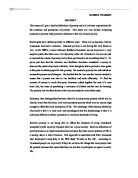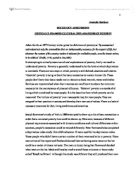As home ownership had increased dramatically during the eighties, homeowners were left counting the cost of high interest rates. The boom in house prices went bust and the number of households in negative equity trebled, peaking at 1.25 million. Mortgage arrears soared to an all time high, and many families lost their homes due to repossession. Higher interest rates also resulted in more job loses as businesses went into liquidation. People with no jobs and those paying higher mortgages had less disposable income; this led to further job loses in retail and in the leisure industry.
From 1979, Britain had a conservative government for eighteen years. During this period, there were radical changes to social and economic policies. The government wanted a free market that would fund a minimal welfare state. Families were encouraged to be responsible for their own welfare. This was a government determined to cut public spending and undermine the dependency culture.
In 1980, the first social security act severed the link between average earnings and long-term benefits, such as pensions. This act increased the gap between those on benefits and those in work. The earnings related supplements payable with contributory benefits was removed, and other benefits were increased at a rate 5 per cent below inflation. (Becker, S.) Child benefit was frozen, and pension increases were linked to inflation rather then the wage index. In 1985, Norman Fowler the minister for Social Security announced a review of benefits. Because of this review, the 1986 social security act was introduced, which came into effect in 1988. In 1988, supplementary benefit became income support, and family income supplement was replaced by family credit. Income support paid premiums according to a person’s need, a disability premium or a family premium are two examples. Young people under 18 became ineligible for Income Support. Unless they were suffering extreme hardship, or on a Youth Training Scheme they received no help from the state. Lower rates of benefit were introduced, for claimants under twenty-five. The social fund was also introduced under this act; this replaced one-off lump sums previously paid to people in urgent need of furniture or clothing. People would now have to apply to the Social Fund for a loan in times of urgent need. This loan would be considered by administrators of the Social Fund, and if granted would have to be paid back out of benefits. Because of these loan repayments, claimants were in further poverty.
There are two definitions of poverty, absolute and relative poverty. Absolute poverty is based on human needs for survival. People who do not have the resources to provide food, clothes, shelter and warmth for themselves are considered to be in absolute poverty. Relative poverty is correlated to a standard of living. People who live in relative poverty do not have the necessary resources to participate fully in the society in which they live. Peter Townsend has carried out several studies of poverty. He considers that society determines people’s needs. Townsend argues that poverty can only be measured in relative terms. In Britain, he considers a Sunday roast, fresh fruit and vegetables every day, days out with the family, participation in sporting events, holidays, birthday presents, Christmas presents all to be part of normal life. Townsend argues that individuals deprived of these activities are in relative poverty.
Explaining the causes of poverty mainly falls into two categories, individualist or cultural and structural.
Individualist theories of poverty were common in the nineteenth century. Herbert Spencer [1874] considered poverty to be the fault of the individual. Spencer considered that if the individual was too lazy to work than they deserved to live in poverty. State assistance was not an option, as this only encouraged idleness. Spencer considered that without poverty the incentive to work would be lost.
Cultural theories of poverty do not blame the individual, but consider it too be the individual’s culture, or subculture. Oscar Lewis studied the urban poor in Puerto Rico and Mexico. Lewis [1959, 1961, and 1966] considered poverty to be cultural as these individuals had a different culture than the rest of society. As these individuals feel marginalised from the rest of society, they are fatalistic, believing their situation to be hopeless. This then makes them less likely to take opportunities on offer to them that may help improve their situation. Lewis considered that these individuals lived life for today, spending rather than saving, with little consideration for the future. [Sociology in Perspective, Heinemann]
Sir Keith Joseph when secretary of State for Education, started an investigation into the problems of poverty this was known as the ‘Cycles of Deprivation’ study. Joseph claimed that ‘despite a continual rise in post-war living standards the reason for continued deprivation and social disadvantage was that it was intergenerationally transmitted. ‘Do we not know only too certainly that among children of this generation there are some doomed to an uphill struggle against the disadvantages of a deprived family background? Do we not know that many of them will not be able to overcome the disadvantages and will become in their turn the parents of deprived families?’ [Keith Joseph, as cited in Poor Work, Brown and Scase, page: 31-32]
David Marsland the British sociologist argues that state welfare payments have gone too far. Marsland considers that welfare benefits have created a society reliant upon benefits. State benefit paid to the unemployed, only encourages them not to seek work, he argues. State benefits may also be a factor in the growth of single parent families, is another point he argues.
Charles Murray developed the cultural theory of poverty further; Murray considers this culture to be amongst the underclass of society. This underclass concept of poverty first emerged in Murray’s controversial book ‘Losing Ground’ published in 1984. In 1989 Murray visited Britain when he stated: ‘When I use the term ‘underclass’ I am indeed focusing on a certain type of poor person defined not by his condition, e.g. long-term unemployed, but by his deplorable behaviour in response to that condition, e.g. unwilling to take the jobs that are available to him.’[Murray 1989, as cited in Sociology Themes and Perspectives, Haralambos and Holborn, 2000 page: 323] Murray considers that the benefit system is too generous and encourages benefit dependency. Murray argues that if you award an individual state benefit to stay at home, the incentive to go out and actively seek employment disappears.
He considers illegitimacy, to be at the very centre of the underclass, the premium paid to single mothers he saw as encouraging illegitimacy. Priority given to women with children in house allocation, and generous state benefits, may make single parenthood an alternative to being self-dependent.
Structural theories of poverty reject the individualistic approach and cultural theory; they blame the structure of society. Research in Britain conducted for the Joseph Rowntree Foundation dismisses the culture of poverty and suggests that situational constraints are responsible for keeping people in poverty. A report published by the Joseph Rowntree Foundation on the 11th September 2000, claims that two million children in Britain are being brought up in poverty. (www.josephrowntreefoundation.org.uk) Social scientists from four universities found 14.5 million people were too poor to afford essentials. Deprivation rates were highest in homes of the unemployed or part time workers, in lone parent households, or homes of the chronically sick or disabled. The report concluded that the government needs to achieve a modest redistribution of wealth to eradicate child poverty.
Frank Field Labour MP considers the underclass to be a result of government policies and social change. Field is of the opinion that the high unemployment rates of the nineteen eighties increased the numbers of the underclass. Single mothers claiming benefits over a long period, are also part of the underclass. Between 1979 and 1987, there was an increase of more than two hundred per cent claiming benefits. [Haralambos and Holborn, Sociology Themes and Perspectives, 2000, page 328]
Retired people who rely on the state pension, who have no means of supplementing their allowance often fall into the underclass.
Field claims the Margaret Thatcher’s policies widened class divisions. Whilst opportunities in society improved living standards and many people became affluent, the poorest in society did not benefit from the growth in the economy. Benefits for the unemployed, the old and the sick, were reduced in real terms. Attitudes changed towards the poor with more people blaming the poor themselves for their plight.
In considering the evidence, it is apparent that there is a great deal of poverty in Britain today. Previous government policies are accountable for some of this poverty. It is this government’s intention to alleviate child poverty in a generation. Although this seems a challenging task, with the correct policies this may be achieved. Although I go along with the structural theory of poverty, some people in society are not prepared to help themselves out of poverty.
BIBLIOGRAPHY
Becker,S. 1997 Responding to Poverty, Harlow: Longman Limited
Brown,P, and Scase. 1991 Poor Work, Open University Press
Haralambos and Holborn. 2000 Sociology Themes and Perspectives, London: Collins
Howard, M. et al 2001 Poverty the Facts, London: CPAG
Kirby, et al 2000 Sociology in perspective, London: Heinemann
www.josephrowntreefoundation.org.uk







